The uniform has always been an important way to identify a profession. For early physiotherapists, eager to define a distinctive identity, the choices were limited. The doctor’s white coat was impractical for physical work, but the nursing-style uniform was more suitable for a female dominated profession. That being said, the addition of epaulettes, different coloured belts, and, crucially, the professional body’s badge or pin, set physiotherapists apart.
As early physiotherapy was conducted in hospitals, uniforms needed to be robust to stand up to being sterilised in hot water. They suffered, as a result, from often being too stiff. Some gym-based therapists pioneered the use of culottes or long gym shorts, and after World War II newer materials gave tops and dresses more flexibility.
Men’s uniforms have passed through a range of different styles, including employing the doctor’s white coat (especially after this began to decline in popularity amongst doctors themselves), and ‘dental’-style tops.
In many countries, physiotherapists have been denoted by their use of blue and white as uniform colours. Lately, uniform styles have relaxed, and a host of different materials, styles, colours, and adornments are used by physiotherapists in the public and private sector.
Description provided by Fiona Jenkins of Wales and David Nicholls of New Zealand.

